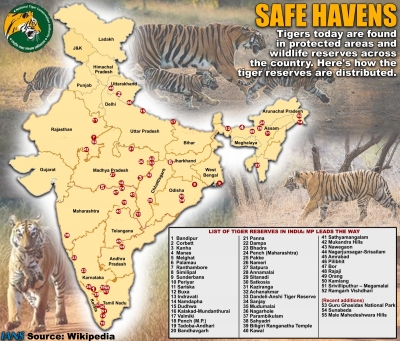
Bhubaneswar, April 8: It seems that the nature-rich Odisha is not a safe place for tigers. While the big cat population in India has witnessed a dramatic increase between 2006 to 2018, the number of wild animals in Odisha has stagnated.
Odisha has two tiger reserves — Similipal located in Mayurbhanj district and Satkosia in Angul district.
Apart from the two tiger reserves, the Bargarh Forest Division, Keonjhar Wildlife Division, Kuldiha Wildlife Sanctuary, Rourkela Forest Division, Sunabeda Wildlife Sanctuary and Sundargarh Forest Division had also reported a presence of the big cats in the past.
According to reports of the National Tiger Conservation Authority (NTCA), the number of tigers in India has increased from 1,441 in 2006 to 2,967 in 2018, the last census conducted.
There were 45 big cats in Odisha in 2006, which went down to 32 in 2010.
When the NTCA conducted another census in 2014, it found only 28 tigers in the state, which remained the same in the last census conducted in 2018.
So, the eastern state has witnessed a fall of nearly 40 per cent in the tiger population during 12 years.
However, the Odisha government had raised a dispute on the 2016 NTCA report, raising questions on its estimation methodology.
If one goes by the census conducted by the Odisha government, as many as 192 tigers were estimated in the state during the year 2004, which plunged to 40 in 2016.
From 2004 to 2016, the number of male tigers decreased from 57 to 13, while the female tiger count slashed to 24 from 75.
There were 60 tiger cubs found in the state during 2004. Surprisingly, only three tiger cubs were found during the estimation conducted by the state government in 2016. This shows the failure of the state government to protect the big cats.
In an effort to raise the tiger population, the Odisha government, with support of NTCA and Madhya Pradesh government, had decided for translocation of three-pairs of tigers to the state.
Thus, India’s first inter-state translocation project was launched in 2018. Under the project, a pair of tigers (Mahavir and Sundari) were translocated to Odisha from Madhya Pradesh.
Officials brought Mahavir from the Kanha Tiger Reserve and Sundari from the Bandhavgarh Tiger Reserve in June 2018 and released them into the Satkosia Tiger Reserve (STR).
The forest department was hopeful the tigers may mate. But Mahavir was found dead in STR only five months later.
The tiger died due to metal snares laid by poachers that caused deep wounds on its neck. The NTCA investigation found that Mahavir had been killed by poachers.
Sundari, after roaming in the wild of Satkosia, attacked local villagers from the periphery villages. She killed two people which triggered protests and resentment from the locals. Later, she was again returned to her origin in Madhya Pradesh.
With thise, the first ever inter-state translocation of tigers failed.
Odisha has excellent habitat and vast forests for tigers to live and flourish. However, rampant poaching is taking a toll on their population.
The forest department has miserably failed to control poaching even in Tiger reserves like Simlipal and Satkosia, said environmentalist Jayakrushna Panigrahi.
Conservation of any animal or forests cannot succeed without the involvement of the local community and people residing inside and near the forest areas. However, the government has failed to do so when it comes to protection of tigers, he said.
The tiger translocation project also failed because of the attitude of the forest officials, Panigrahi pointed out.
An official said the forest department has formed a nine-member advisory committee to advise the state government regarding taking up a tiger conservation programme with a view to re-establishing source population in Satkosia and Debrigarh tiger reserves and enhancing the population and gene pool in Similipal tiger reserve.
The government will take initiative as per the recommendation of the panel, he said.






